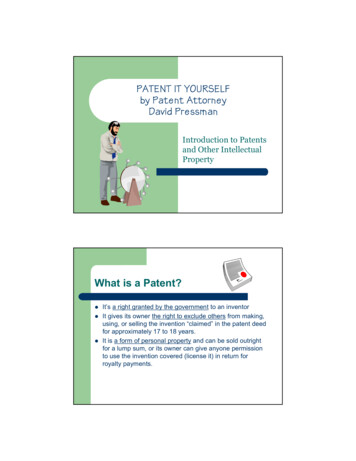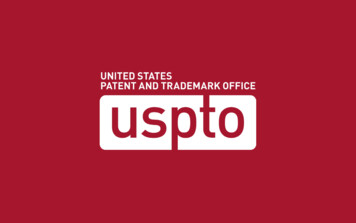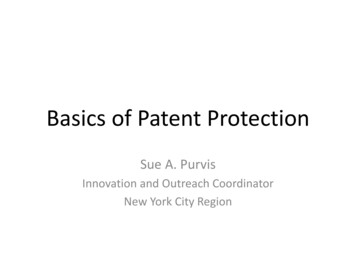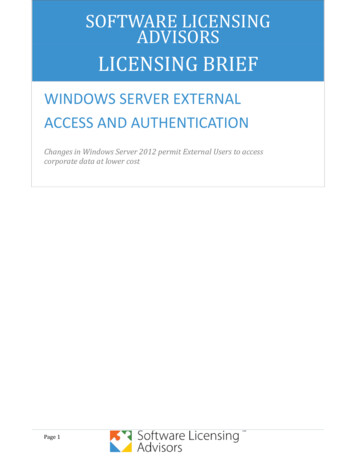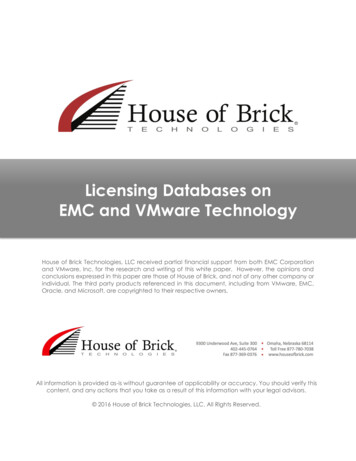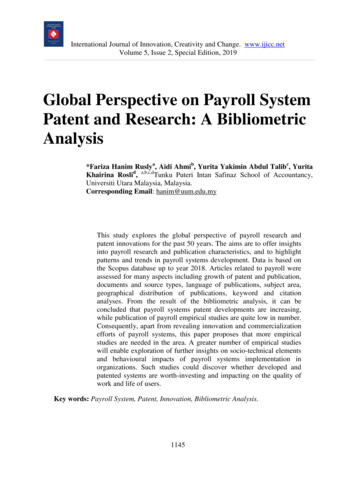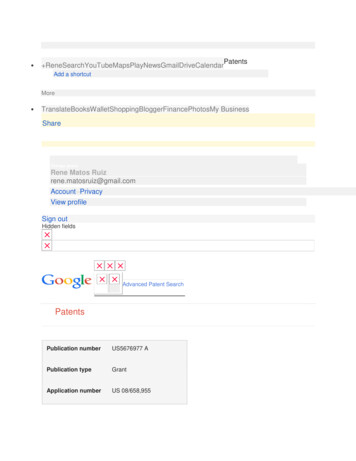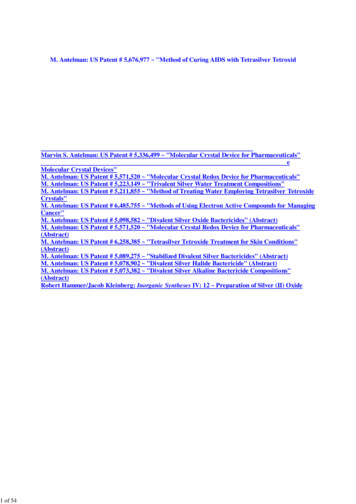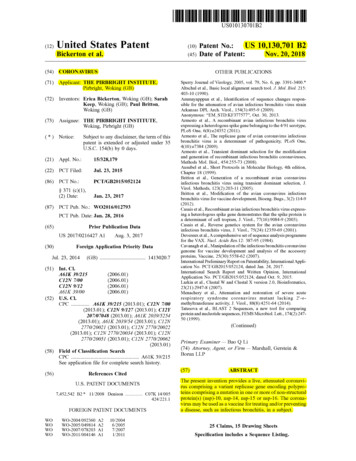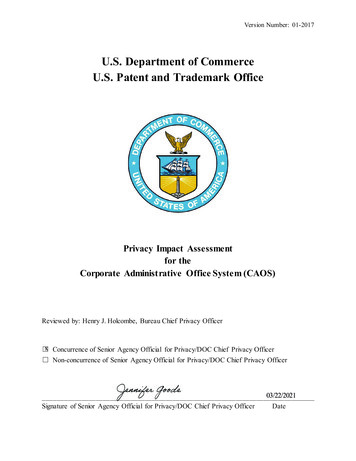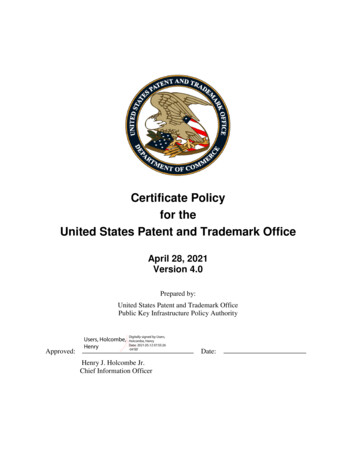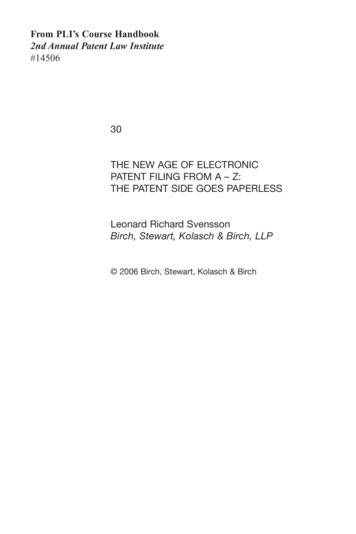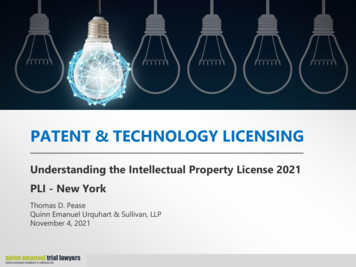
Transcription
PATENT & TECHNOLOGY LICENSINGUnderstanding the Intellectual Property License 2021PLI - New YorkThomas D. PeaseQuinn Emanuel Urquhart & Sullivan, LLPNovember 4, 2021
Overview General Background Information Patent Licensing Basics Standard License Terms and Scope Certain Considerations to Be Aware Of Patent vs. Technology Licenses License Agreements in LitigationPLI: Patent & Technology Licensing2
BackgroundPLI: Patent & Technology Licensing3
What is a Patent? Patents convey certainexclusive rights. Grant by US Governmentto a limited monopoly onnew and useful inventions. U.S. Patent & TrademarkOffice Scope of exclusive rightsdepends on the “claims”of a patent.PLI: Patent & Technology Licensing4
Constitutional Origin US Constitution, Article I, Section 8:The Congress shall have the Power Topromote the Progress of Science and useful Arts,by securing for limited Times to Authors andInventors the exclusive Right to their respectiveWritings and DiscoveriesPLI: Patent & Technology Licensing5
Parts of a Patent Front page – bibliographic information Title, abstract, inventors, filing/issue dates, assignee, citations Can be multiple pages if long list of citations Claims – define the scope of exclusive rights “an apparatus comprising: component a, component b, ” “a method comprising: step 1, step 2, ” Specification – written description Claims (at the end of spec and considered part of spec) Drawings (after title page and considered part of spec)PLI: Patent & Technology Licensing6
The Scope of a Patent Is Defined by ClaimsPLI: Patent & Technology Licensing7
Patent Conveys a Bundle of Rights A patent conveys a bundle of rights on the patentee: A right to exclude others from making, importing, using,and/or selling covered products A right to enforce—i.e., to sue infringers A right to transfer or license the patent A right to share in royalties or damages that flow from thepatent A right to prosecute child applications and foreigncounterpartsPLI: Patent & Technology Licensing8
Patent Conveys Right to Exclude Others A patent conveys right to exclude others from: Making, using, offering to sell, or selling the patentedinvention Or importing into the United States the patented invention It does not convey an affirmative right to make, use,offer to sell or sell Such products might infringe the patents of others Licensing others to practice a patent is a key function ofpatent licensingPLI: Patent & Technology Licensing9
Patent Term Beginning on the issue date. Ending 20 years from the earliest effective filing date ofthe U.S. non-provisional application on which the patentwas granted. Includes Patent Cooperation Treaty (PCT) applications fromwhich the patent claims priority May be eligible for an extension or adjustment of term,which is reflected on the cover of the patent. After a patent expires, its subject matter passes into the“public domain.”PLI: Patent & Technology Licensing10
What is a Patent License? “[A] patent license agreement is in essence nothingmore than a promise by the licensor not to sue thelicensee.” Imation Corp. v. Koninklijke Philips Elecs. N.V., 586 F.3d 980,987 (Fed. Cir. 2009). Of course, a patent license can include muchmore than this basic promise.PLI: Patent & Technology Licensing11
Why License? Generate revenue Might be more economical to license others than to practice thepatent yourself Strategic cross-license Receive rights to practice patents in return for rights to yourown Avoid foreseeable patent litigation/settle litigation Business endeavors, e.g., joint ventures, consultingagreements, manufacturing/distribution agreements Mergers/acquisitions/divestituresPLI: Patent & Technology Licensing12
Patent Licensing BasicsPLI: Patent & Technology Licensing13
Goals of License Drafting Think through and memorialize business relationship Define rights and obligations of the parties Avoid ambiguity Avoid implied obligations Address future eventsPLI: Patent & Technology Licensing14
Types of Patent Licenses Non-exclusive License Exclusive License License limited to a geographical area or fields of use Assignment (more than a license)PLI: Patent & Technology Licensing15
Non-Exclusive (“Bare”) License Non-exclusive license mere promise not to sue licensee: “[A] bare license. . . merely [grants] a privilege [to the licensee] thatprotects him from a claim of infringement by the owner. . . Hence thepatent owner may freely license others, or may tolerate infringers, andin either case no right of the patent licensee is violated.” Ortho Pharm.Corp. v. Genetics Inst., Inc., 52 F.3d 1026, 1031 (Fed. Cir. 1995). Covenant not to sue – tantamount to a license Non-Exclusive Licensee has no rights to exclude others No standing to sue for infringement Does not imply transfer of technology or know-howPLI: Patent & Technology Licensing16
Non-Exclusive (“Bare”) LicenseExample:LICENSOR hereby grants to LICENSEE a royalty-bearing,nonexclusive right and license, under all claims of thePatent to make, have made, use, sell, import, lease andotherwise dispose of Products, subject to the terms andconditions set forth in this Agreement.See Eckstrom - Forms § 5:11PLI: Patent & Technology Licensing17
Exclusive License An exclusive license gives the licensee the right toexclude others: “[A]n exclusive license is a license to practice the invention . . .accompanied by the patent owner's promise that others shall beexcluded from practicing it within the field of use wherein thelicensee is given leave.” Int'l Gameco, Inc. v. Multimedia Games,Inc., 504 F.3d 1273, 1277 (Fed. Cir. 2007) (internal citations andquotations omitted). An exclusive licensee can sue for infringement if thepatent owner is joined as a plaintiffPLI: Patent & Technology Licensing18
Exclusive LicenseExample:Licensor hereby grants to Licensee an exclusive licenseto manufacture timekeeping modules incorporating theteachings of the invention in New York and to sell suchas Licensed Products, whether alone or incorporatedinto complete closures, as may be specified by Licensorfrom time to time throughout the world, provided thatLicensee may only sell such modules or closures toLicensor or to persons or entities specified in writing byLicensor.See Eckstrom - Forms § 5:11PLI: Patent & Technology Licensing19
Geographic and Field of Use Restrictions Field of use restrictions are common, either alone or incombination with territorial restrictions exclusive as to particular distribution chains “the DTC Market and Retail Market” exclusive as to a particular embodiment “Hunting and ice fishing blinds ONLY. Not for Camping orany other use” exclusive as to an intended product use “dentifrice compositions for human oral use” “an exclusive license to . . . rechargeable batteries witha solid electrolyte, gelled, plasticized or not plasticized”PLI: Patent & Technology Licensing20
Assignment (Conveyance of Ownership) An assignment is a grant of “all substantial rights” undera patent. 35 U.S.C. § 261:Subject to the provisions of this title, patents shall have the attributes ofpersonal property. The Patent and Trademark Office shall maintain a registerof interests in patents and applications for patents and shall record anydocument related thereto upon request, and may require a fee therefor.Applications for patent, patents, or any interest therein, shall be assignable inlaw by an instrument in writing. The applicant, patentee, or his assigns orlegal representatives may in like manner grant and convey an exclusive rightunder his application for patent, or patents, to the whole or any specifiedpart of the United States. PTO assignment records available at https://assignment.uspto.govPLI: Patent & Technology Licensing21
AssignmentExample:Now, therefore, in consideration of the sum of 1, OWNERdoes by these presents sell, assign, transfer, and set over untoBUYER all of its right, title, and interest in and to the saidLetters Patent, the same to be held and enjoyed by said BUYERfor her own use and behoof, and for the use and behoof of herheirs, executors, administrators, and assigns, to the full end ofthe term for which the said Letters Patent are granted, as fullyand entirely as the same would have been held and enjoyed byOWNER had this assignment and sale not been made.See Eckstrom - Forms § 5:69PLI: Patent & Technology Licensing22
Assignment Only the owner/assignee of a patent application may prosecute the application; file continuations, divisionals, continuations-in-part ; defend inter partes review or ex parte reexaminations Sue for infringement alone There can be multiple, partial assignees (e.g., inventorswho have not assigned their rights). all assignees must participate in prosecution Make sure Licensor has the entire right, title and interestin the application or patent being licensed (i.e., Licensorincludes all assignees).PLI: Patent & Technology Licensing23
License Terms and ScopePLI: Patent & Technology Licensing24
Parts of a Patent License Agreement Introduction, “whereas” clauses Address purpose of agreement Definitions License Grant Development/Commercialization? Payment/considerationPLI: Patent & Technology Licensing25
Other Standard Terms Confidentiality Term & Termination Survival Assignment Reps & Warranties Indemnification Ownership & Improvements Choice of Law and Venue Release for past infringementPLI: Patent & Technology Licensing26
Definitions Parties Licensed Patents Licensed Products Net sales Fields of use Common definitions Affiliates/subsidiaries Later formed or acquired Automatic or requiring affirmative action to invoke Net salesPLI: Patent & Technology Licensing27
Definition: Licensed Patents Carefully define to avoid ambiguity Single patent, a group of patents, or all owned patents, e.g., all patentsnecessary to practice 3GPP UMTS (3G) standard Limited to US, or all patents worldwide, or something in between? Are related patents, e.g., continuations, divisionals, continuations-in-part, reissues, foreign counterparts included? Presumption that all continuations are included unless agreementstates otherwise Are patents obtained during the pendency of license included What if licensor transfers patent? Define field of use precisely E.g., if limited to sales for use in “high end” products, make sureparties know what “high end” means.PLI: Patent & Technology Licensing28
License Grant Conveys rights to the licensee Licensor should expressly reserve the rights it wishes to retain Right to make, use, sell, offer for sale, import into the U.S. Implied rights Right to sublicense? Exclusive or non-exclusive Perpetual or term Irrevocable? Fully paid up, royalty bearing or royalty free Consider exhaustion Technology or know how included? May impose limitations Geographic scope of license Field of usePLI: Patent & Technology Licensing29
License Grant Limiting rights for certain downstream users Define Third-Party Beneficiaries (e.g., customers, end users,distributors, partners, OEMs, etc.) Carve out entities to whom rights should not extend Exhibit identifying such entities Carve out rights as appropriate (e.g., no license to sell to entitiesin Exhibit X, no license to bundle products with entities in ExhibitY, no license to provide support to entities in Exhibit Z, etc.) Carve out rights that might be implied E.g., No right to have chips made (“have made” rights)PLI: Patent & Technology Licensing30
Example: Simple License Grant (Harvard)2. License Grant.2.1. License. Subject to the terms and conditions set forth in thisAgreement, Harvard hereby grants to Licensee a non-exclusive,worldwide, non-transferable, royalty-bearing license under thePatent Rights solely to develop, make, have made, use, market, offerfor sale, sell and import Licensed Products in the Field.https://otd.harvard.edu/upload/files/Sample NonExclusive License Agreement.pdfPLI: Patent & Technology Licensing31
Payment/Consideration Royalty bearing, fully paid up, royalty free Define the consideration, e.g.: Lump sum payment(s) Royalties (percentage of sales, tiered royalties, etc.) Milestones Royalty rate Royalty base FRAND obligation? Most favored nations clausePLI: Patent & Technology Licensing32
Payment/Consideration Example of Royalty Bearing License: LICENSEE agrees to pay to LICENSOR a royalty of 10% of NetSales for each appliance sold by LICENSEE after January 1, 2018,embodying the invention of said Patent No. 1,111,111.See Eckstrom - Forms § 5:21PLI: Patent & Technology Licensing33
Payment/Consideration Enforcement Pros and cons for all structures Running royalties typically require: Periodic royalty reports Audit rights But licensee only pays based on actual infringement Lump sum Avoids need to predict But assumptions about infringing sales are important (can also triggeradditional payments based on total sales) Termination Automatic upon breach or curable? If terminated, remedy going forward is infringement as opposed tobreach of contractPLI: Patent & Technology Licensing34
Payment/Consideration Sometimes parties may not want royalty terms to be easily assessedby others (e.g., by opponent in a litigation) E.g., standard essential patents must often be licensed on FRANDterms and conditions Fair, Reasonable and non-discriminatory Licensor may try to establish or maintain a high royalty rate Can include other rights (that are not readily quantifiable) in a lump sumagreement to make it difficult for others to later back out the specificroyalty attributable to the patents-in-question May include self-serving language stating parties’ agreement as toimplied royalty rate.PLI: Patent & Technology Licensing35
Commercialization Some license agreements could impose an obligation on thelicensee to develop and commercialize the invention. Diligence, development plan, reporting requirements, milestonescan all be defined to ensure that a licensee is commercializing theinvention. Gives opportunity to licensor to terminate agreement if a licensee isin material breach of this requirement. Licensor may not want a licensee to sit on invention rather thancommercialize it.See Harvard Sample Non-Exclusive Patent License.PLI: Patent & Technology Licensing36
Confidentiality Protects bargaining position, e.g., when negotiating withbusiness partners of different market values Protects business relationships, e.g., allows a company toenter into agreements with two competitors Protects plaintiff’s bargaining position with remaininglitigants, or future targets Protects secrecy of new products or processes underdevelopment But almost always discoverable subject to a protective order Consider requirement for advance notice (and/or express writtenconsent) when agreement subject to production in litigationPLI: Patent & Technology Licensing37
Term & Termination Term: Duration (until last to expire or for a term of years) Termination: With notice, in writing, for any reason If performance goals not met In the event of an acquisition/sale Consider impact of one-way termination for breach E.g., Licensor retains rights under agreement whereaslicensee may lose rights Carefully specify cure mechanism and timingPLI: Patent & Technology Licensing38
Survival Defines what obligations remain in effect after thelicense expires or is terminated Confidentiality Right to assign to subsidiariesPLI: Patent & Technology Licensing39
Assignment of License Agreement can define whether and how a licensee cantransfer its rights to another. May require written notice to licensor May require consent of licensor May limit who can be an assignee of license May prohibit assignment, whether express or by acquisition A licensor may not want to give the ability to grantfurther licenses under the patents. Assignment agreement Acquisition of licensee NovationPLI: Patent & Technology Licensing40
Reps & Warranties Confirm licensor’s ownership of IP and right to license it No encumbrances Validity/enforceability of the patents E.g., payment of patent maintenance fees No infringement by third-parties DisclaimersPLI: Patent & Technology Licensing41
Indemnification Gives licensee the ability to seek indemnification fromlicensor in infringement actions Gives licensor the ability to seek indemnification fromlicensee in products liability actions Specifies: costs/expenses covered, what IP/products arecovered, upper limits on indemnification, etc. May vary from industry to industry Who controls litigation?PLI: Patent & Technology Licensing42
Ownership & Improvements Sets forth which party will own improvements to thelicensed technology Defines an “improvement” May include time limits and/or notice obligationsPLI: Patent & Technology Licensing43
Licensing Flexibility The parties may tailor provisions to their needs, e.g.: Subject matter: may cover a single patent, an entire patentportfolio, an entire patent family (including not yet issuedpatents); Territorial Scope: the world, the United States, or some smallerterritory; Scope of Grant: a single product or service provided bylicensee, or an entire line of products or services, or an entirearea of technology; Temporal Scope: the duration of the patent, or any shortertime; Royalties: percentages, lump sum, milestones, etc.PLI: Patent & Technology Licensing44
Licensing ConsiderationsPLI: Patent & Technology Licensing45
License for Royalties After Expiration Patentee may not license for royalties after theexpiration of the patent’s term “A patent empowers the owner to exact royalties as high as hecan negotiate with the leverage of that monopoly. But to usethat leverage to project those royalty payments beyond the lifeof the patent is analogous to an effort to enlarge the monopolyof the patent by tieing the sale or use of the patented article tothe purchase or use of unpatented ones.” Brulotte v. Thys Co.,379 U.S. 29, *33 (1964).PLI: Patent & Technology Licensing46
FRAND Obligations What if a technology standard (e.g., 802.11 wirelessprotocol) is covered in whole or in part by a patent? Owners of such a standard essential patent (SEP) wouldhave considerable market leverage, resulting inunreasonable royalty demands – “holdups” Solution: FRAND obligations Standard Setting Organizations (SSOs) require patentees tolicense SEP patents (if involved in SSO activities) SSOs also require Fair, Reasonable, and Non-Discriminatorylicense terms (FRAND)PLI: Patent & Technology Licensing47
Patent Marking 35 U.S.C. § 287 – if patentee or its licensees fail to mark,then no pre-suit damages against infringers who werenot on actual notice of the patent(s) Solution: marking obligations Require licensee to mark products that practice licensedapparatus or system patents (n.b., no marking requirement formethod patents) Require licensee to provide periodic notices identifying productsthat practice licensed patents, with proof of compliance withmarking requirements Monitor licensee to ensure marking Infringer’s knowledge of patent irrelevantPLI: Patent & Technology Licensing48
Competitive Landscape What if a competitor acquires the licensee in order togain access to your technology? Solution: anticipate through various terms in the license Ability to terminate without cause if licensee is acquired Limit scope of use of licensed patents/technology to licensee’sproducts existing at the time of the license and naturalevolutions thereof As mentioned before: include carve outs; and limit ability toassign license These concerns favor a running royalty over a lump sumapproachPLI: Patent & Technology Licensing49
Patent vs. Technology LicensesPLI: Patent & Technology Licensing50
Know-How Licenses “Know-how”: covers a body of knowledge outside of the publicdomain, e.g., trade secrets, formulae, marketing schemes orlaboratory practices. Goes beyond simply allowing the licensee to practice a patent The licensor is affirmatively providing information to the licenseethat it can use to make products or implement processes. Confidentiality is key – once the general public gains access, itis no longer valuable E.g., Coca-Cola’s secret formulaSee Eckstrom § 6.PLI: Patent & Technology Licensing51
Know-How Licenses If licensed know-how includes trade secrets, then include measures tolimit dissemination and maintain confidentiality Limit access on a need-to-know basis Identify security requirements to be implemented by licensee (e.g., trade secretskept in secured room without internet access) Require maintenance of access logs Audit rights to ensure security measures are implemented If know-how being licensed for use or implementation in a softwareproduct Beware of open source code used by licensee in the same product Ensure licensee does not inadvertently include licensed know-how in anycopyright applications Require licensee to harden its software against reverse engineeringPLI: Patent & Technology Licensing52
Other Licensable Subject Matter Unpatented inventions Pending patent applications Technology & ImprovementsPLI: Patent & Technology Licensing53
Patent Licenses in LitigationPLI: Patent & Technology Licensing54
Patent Damages License terms can affect damages in litigation. Patent damages per 35 USC § 284:“damages adequate to compensate for the infringement, but inno event less than a reasonable royalty for the use made of theinvention by the infringer” Fifteen Georgia-Pacific factors are used to helpdetermine a reasonable royalty. Georgia-Pacific Corp. v. United States Plywood Corp., 318 F. Supp.1116 (S.D.N.Y. 1970). Some of the factors are impacted by patent licensescovering the patents-in-suit or comparable patents.PLI: Patent & Technology Licensing55
Patent Damages – Relevant GeorgiaPacific Factors1. The royalties received for the licensing of the patent-in-suit.;2. The rates paid for the use of comparable patents;3. The nature and scope of the [hypothetical] license, as exclusive ornon-exclusive, or as restricted or non-restricted in terms of territoryor with respect to whom the manufactured product may be sold;.15. The amount that a prudent licensee – who desired, as a businessproposition, to obtain a license to manufacture and sell a particulararticle embodying the patented invention – would have been willingto pay as a royalty and yet be able to make a reasonable profit, andwhich amount would have been acceptable by a prudent patentowner who was willing to grant a license.PLI: Patent & Technology Licensing56
Standing Assignment confers to assignee constitutional standingto sue for infringement. An exclusive licensee may bring suit for infringement,but must join the patent owner. BUT a non-exclusive licensee has no standing to bringor join an infringement action (no injury) See, e.g., Intellectual Prop. Dev., Inc. v. TCI Cablevision of Cal., Inc.,248 F.3d 1333, *1345-48 (Fed. Cir. 2001) (cert. denied).PLI: Patent & Technology Licensing57
Exclusive License or Assignment? If a purported “exclusive license” grants “all substantialrights,” courts deem it an assignment. Courts consider nine Azure factors, e.g., The nature and scope of the right to bring suit; The exclusive right to make, use and sell products/servicescovered by the patent; The scope of licensee’s right to sublicense.See Azure Networks, LLC v. CSR PLC, 771 F.3d 1336, 1343 (Fed. Cir.2014)PLI: Patent & Technology Licensing58
Jurisdiction – State or Federal? Where do we litigate a contract (state) covering a patent(federal question)? Key question: Does the claim or defense implicatepatent law? Examples: A claim or defense related to infringement or invalidity (federal); A dispute as to the inventorship of a patent (federal); A dispute as to an ownership interest in a patent (state); A dispute as to unpaid royalties (state). See, e.g., Alexsam, Inc. v. Wildcard Sys., Inc., No. 16-15829-CC (11th Cir. 2017); Krauser v.BioHorizons, Inc., 753 F.3d 1263 (Fed. Cir. 2014).PLI: Patent & Technology Licensing59
Estoppel: License vs. Assignment Licensee estoppel: licensee estopped from arguing thatthe patents it licensed are invalid, i.e., worthless SCOTUS abolished licensee estoppel, reasoning that the publicinterest in free competition outweighed equities of the licensor.See Lear, Inc. v. Adkins, 395 U.S. 653 (1969). Assignor Estoppel: same concept applied toassignments Assignor estoppel consistently upheld by the Federal Circuit, asrecently as 2017. See Mentor Graphics Corp. v. EVE-USA, Inc., 851F.3d 1275 (Fed. Cir. 2017). Federal Circuit held that assignor estoppel did not apply to IPRproceedings, relying on the statutory language in the AIA. AristaNetworks v. Cisco Systems, (Fed. Cir. 2018).PLI: Patent & Technology Licensing60
Patent Exhaustion When a patent owner sells one of its covered products, itspatent rights “exhaust” – can’t sue downstream buyers forinfringement “Allowing patent rights to stick remora-like to that item as it flowsthrough the market would violate the principle against restraints onalienation.” Impression Prods. v. Lexmark Int'l, Inc., 137 S. Ct. 1523,*1528 (2017). In Lexmark SCOTUS confirmed the broad scope of patentexhaustion: Sales contracts with provisions prohibiting resale by Buyer do notexempt Buyer’s subsequent resales from triggering exhaustion Foreign sales trigger exhaustion “[R]estrictions and location are irrelevant; what matters is thepatentee’s decision to make a sale.” Id. at *1538.PLI: Patent & Technology Licensing61
Lexmark Lexmark distinguishes sales vs. limited licenses: “A patentee can impose restrictions on licensees. . . [b]ecausethe patentee is exchanging rights, not goods, it is free torelinquish only a portion of its bundle of patent protections.” Id.at *1534. “[Where] a licensee knowingly ma[de] . . . sales . . . outside thescope of its license. . . [w]e treated the sale as if no licensewhatsoever had been granted by the patentee, which meant thatthe patentee could sue both the licensee and the purchaser—who knew about the breach—for infringement.” Id. at *1535.PLI: Patent & Technology Licensing62
FRAND Obligations What makes a license FRAND? “The search for precision and absolute certainty is a doomedundertaking. The complexity of the analyses and the number ofvariable components inevitably lead to criticism.” TCL Comm.Tech. Holdings Ltd. v. Telefonaktiebolaget LM Ericsson, 2017 WL6611635, 7 (C.D. Cal. 2017). Problems with calculating FRAND rates Transparency: licensing agreements/offers are confidential; Consistency: no universal FRAND methodology; Comprehensiveness: FRAND focuses only on the assertedpatentSee “Global Rate-Setting: A Solution for Standards-Essential Patents?” Jorge L. Contreras (July 13, 2018),available at: g-law-review-article-jlc-07-12-18.pdf.PLI: Patent & Technology Licensing63
FRAND: Varied Approaches “Bottom Up”: Use the Georgia Pacific factors (normallyused to calculate “reasonable royalties” in damagescontext). “Top Down”: Multiply the maximum expected royaltyrate times SEP owner’s market share, adjusted forregional strength. Other: FRAND is not a statutory requirement, so themethodologies are as numerous as the jurisdictionswhere cases are broughtSee, e.g., TCL Comm. Tech. Holdings, Ltd. et al. v. Telefonaktiebolaget LM Ericsson, et al. No. SACV 14-341 JVS(DFMx) (C.D. Cal. 2017); Microsoft Corp. v. Motorola, Inc., 2013 U.S. Dist. LEXIS 60233, *52-53 (W.D. Wash. 2013);see also Georgia-Pacific Corp. v. United States Plywood Corp., 318 F. Supp. 1116, 1120 (S.D.N.Y. 1970).PLI: Patent & Technology Licensing64
Questions?
Nov 04, 2021 · Patent Conveys a Bundle of Rights A patent conveys a bundle of rights on the patentee: A right to exclude others from making, importing, using, and/or selling covered products A right to enforce—i.e., to sue infringers A right to transfer or license the patent A right to share in royalties or damages that flow from the patent
